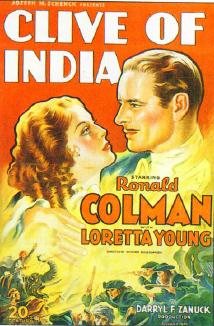Plot
In 1748, the British, French, Dutch and Portuguese are fighting over India.
Back in England, Robert Clive fires and misses in a duel; his opponent walks up to him, points his pistol at Clive's head and demands he retract his accusation of cheating. When Clive refuses, the other man declares him "mad" and leaves. Later, frustrated with the boredom of being a clerk, Clive recalls firing a pistol at his own head and having it misfire twice, only to have his friend fire it without a problem. This causes him to wonder if he is "destined for something after all."
He is sent to India in disgrace, still a clerk (for the East India Company at Fort St. George). He is fascinated by a picture of a beautiful woman in the locket of his friend and fellow clerk Edmund Maskelyne. He discovers that she is Edmund's sister and declares he wants to marry her, even though they have never even met. He later brazenly writes to her, asking her to come to India, a year-long journey.
When the French attack, Clive sees his destiny, as a soldier. The army is poorly manned and led. He persuades Edmund into transferring to the army as well. When the British are besieged in Trichinopoly, Clive sneaks out through the enemy lines without orders to confront the British Governor Pigot and his council. Finding they have no idea what to do, he offers to lift the siege, even though they can raise only 120 men, by attacking Arcot, the "capital of southern India". They agree. Clive sets out immediately with his small force, captures Arcot and raises the siege. In less than a year, he conquers all of southern India.
Margaret arrives, but is intimidated by his great success. His plans are unchanged, however, and they get married. They return to England to a magnificent London mansion. He wins a seat in Parliament, then loses it. Clive loses all his money showering (unwanted) luxuries on his wife and contesting elections. Fortunately, the East India Company wants him to return to India.
Colonel Clive demands the unconditional release of 146 British prisoners, but King of "Northern India" Suraj Ud Dowlah throws them into the "Black Hole of Calcutta"; only a handful survive the ordeal. Enraged, Clive makes a secret treaty with Suraj's uncle, Mir Jaffar, despite lacking the authority to do so. Royal Navy Admiral Watson refuses to sign the treaty, but Clive forges his signature.
Advancing against the enemy, Clive hesitates to cross a river, soon to be made impassible by the annual monsoon rains, without a firm commitment from Mir Jaffar. The governor and Edmund Maskelyne advise caution, and he reluctantly orders a retreat, but a supportive letter from his wife changes his mind, and Clive boldly leads his small army across. After much initial success, his men are about to be routed by Suraj's war elephants at the Battle of Plassey when Mir Jaffar finally commits his forces, ensuring victory.
Clive sails home to England to enjoy retirement on a country estate with his wife. However, Picot arrives with dire news: India is in chaos, all those Clive placed in power have been replaced by corrupt men, and Mir Jaffar has been deposed. Pigot offers Clive absolute authority to set things right. Clive accepts, but his decision comes at the cost of a rupture with his wife, who refuses to go with him.
Clive not only restores the situation, he expands the territories controlled by the British. However, all the men he got rid of travel to England and accuse him of accepting bribes. Clive defends himself, but to no avail. At this dark time, his wife returns to him. The Prime Minister himself brings the news: the verdict is not in his favour, but he will most likely be allowed to retain his wealth and honour. The Prime Minister also passes along the private praise of King George.
